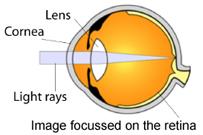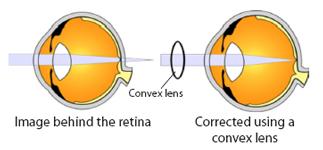Refractive Errors
Refractive Errors
What are refractive errors?
 In normal vision, light rays from an object focus on the retina (emmetropia). Alternatively, in the presence of refractive error, the light rays get focused in front or behind the retina causing blurred vision. Under normal conditions, as the eye ball grows in size from infancy to adulthood, there will be a corresponding change in curvature of cornea and the lens, enabling the eye to remain emmetropic, at all ages.
In normal vision, light rays from an object focus on the retina (emmetropia). Alternatively, in the presence of refractive error, the light rays get focused in front or behind the retina causing blurred vision. Under normal conditions, as the eye ball grows in size from infancy to adulthood, there will be a corresponding change in curvature of cornea and the lens, enabling the eye to remain emmetropic, at all ages.
When one of these happens, refractive error occurs:
- The eye ball being larger or smaller than the normal size
- The corneal curvature being flatter or steeper than usual
- Increase or decrease in the power of the lens
Symptoms of Refractive Errors
- Children can have difficulty in reading small letters on the blackboard
- Some children squeeze their eyes while trying to see distant objects like blackboard, television etc.
- Children hold books close to their face while reading
- Children with myopia have defective vision for distance and clear vision for near.
- They can experience eye strain while trying to read for long hours.
- Some children with hyperopia can present with squint.
- Children can develop swellings on the lids due to constant rubbing of the eyes to see things clearly.
- Eye pain and headache may occur.
The child should be immediately brought to an ophthalmologist, if any one of the above symptoms is observed.
The refractive errors can be classified as myopia (near sightedness) and hyperopia (far sightedness)
What is hyperopia?

In hyperopia or far sightedness, the light rays from an object form an image behind the retina.
Children with hyperopia
- find difficulty in reading, writing and looking at both near and distant objects.
- Face eye strain while trying to read for long hours
- may have squint (crossed eyes)
What is myopia?

In myopia or near sightedness, the light rays from an object form an image in front of the retina.
Children with myopia
- Have defective vision for distance and clear vision for near
- squeeze their eyes while trying to see distant objects
- hold books close to their face while reading
Children with the above conditions may also
- rub their eyes constantly or blink frequently, because of the eye strain which they experience all the time or have pain, watering or burning sensation in the eyes
- have headache in the forehead region which gets intensified in the evening
- have recurrent swellings in the eye lids.
Astigmatism

This occurs due to changes in corneal curvature.
Treatment for the above conditions
- Correction using spectacles is the best option available. Though children may initially refuse to accept glasses, they will become fond of them once they realise they can see better with them on.
- The power of the glasses may change depending on the growth of the eye ball. An eye check-up and change of glasses if necessary, has to be done once in 6 months for children under 5 years of age and once a year thereafter. Making a child wear glasses regularly is the duty and responsibility of the parents.
- Failure to wear glasses in childhood when needed will retard the development of vision in that eye.
- Children older than 15 years can use contact lenses if they don’t want spectacles. Those over 18 to 20 years of age with stable power also have the option of LASIK, a laser refractive surgery apart from contact lenses.
Failure to correct the refractive errors and the eventual low vision may hamper the academic activities of the child. So an ophthalmic consultation is essential in children, especially with symptoms of refractive errors. Finally, there is no relationship between nutritional deficiency and the occurrence of refractive error. So loading these children with Vitamin A will not help them. Sometime this may lead on to other complications.
Source: Aravind Eye Care
ಕೊನೆಯ ಮಾರ್ಪಾಟು : 2/20/2020
